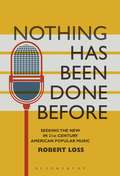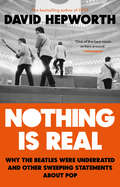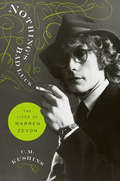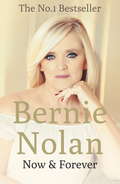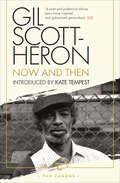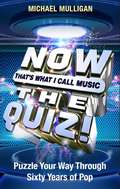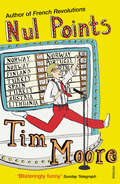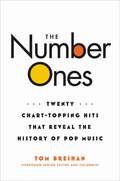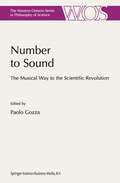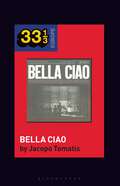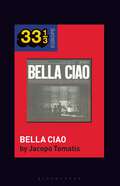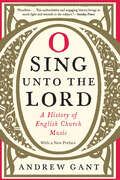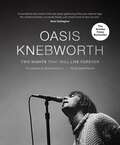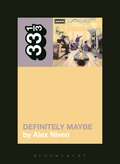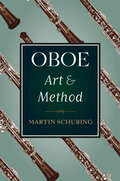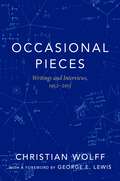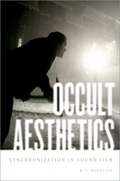- Table View
- List View
Nothing Has Been Done Before: Seeking the New in 21st-Century American Popular Music (Alternate Takes: Critical Responses to Popular Music)
by Robert LossIs there such a thing today as music that's meaningfully new? In our contemporary era of remixing and retro styles, cynics and romantics alike cry "It's all been done before" while record labels and media outlets proclaim that everything is new. Coded into our daily conversations about popular music, newness as an artistic and cultural value is too often taken for granted.Nothing Has Been Done Before instigates a fresh debate about newness in American pop, rock 'n' roll, rap, folk, and R&B made since the turn of the millennium. Utilizing an interdisciplinary approach that combines music criticism, philosophy, and the literary essay, Robert Loss follows the stories of a diverse cast of musicians who seek the new by wrestling with the past, navigating the market, and speaking politically. The transgressions of Bob Dylan's "Love and Theft". The pop spectacle of Katy Perry's 2015 Super Bowl halftime show. Protest songs against the war in Iraq. Nothing Has Been Done Before argues that performance heard in a historical context always creates a possibility for newness, whether it's Kendrick Lamar's multi-layered To Pimp a Butterfly, the Afrofuturist visions of Janelle Monáe, or even a Guided By Voices tribute concert in a local dive bar. Provocative and engaging, Nothing Has Been Done Before challenges nothing less than how we hear and think about popular music-its power and its potential.
Nothing is Real: The Beatles Were Underrated And Other Sweeping Statements About Pop
by David HepworthPop music’s a simple pleasure. Is it catchy? Can you dance to it? Do you fancy the singer?What’s fascinating about pop is our relationship with it. This relationship gets more complicated the longer it goes on. It’s been going on now for 50 years.David Hepworth is interested in the human side of pop. He’s interested in how people make the stuff and, more importantly, what it means to us. In this wide-ranging collection of essays, he shows how it is possible to take music seriously and, at the same time, not drain the life out of it. From the legacy of the Beatles to the dramatic decline of the record shop, from top tips for bands starting out to the bewildering nomenclature of musical genres, with characteristic insight and humour, he explores the highways and byways of this vast multiverse where Nothing Is Real and yet it is, emphatically and intrinsically so. Along the way he asks some essential questions about music and about life: is it all about the drummer; are band managers misunderstood; and is it appropriate to play ‘Angels’ at funerals?As Pope John Paul II said ‘of all the unimportant things, football is the most important’. David Hepworth believes the same to be true of music and this selection of his best writing, covering the music of last fifty years, shows you precisely why.
Nothing's Bad Luck: The Lives of Warren Zevon
by C. M. KushinsBiography of legendary singer-songwriter Warren Zevon, spanning his nomadic youth and early recording career to his substance abuse, final album, and posthumous Grammy AwardsAs is the case with so many musicians, the life of Warren Zevon was blessed with talent and opportunity yet also beset by tragedy and setbacks. Raised mostly by his mother with an occasional cameo from his gangster father, Warren had an affinity and talent for music at an early age. Taking to the piano and guitar almost instantly, he began imitating and soon creating songs at every opportunity. After an impromptu performance in the right place at the right time, a record deal landed on the lap of a teenager who was eager to set out on his own and make a name for himself. But of course, where fame is concerned, things are never quite so simple.Drawing on original interviews with those closest to Zevon, including Crystal Zevon, Jackson Browne, Mitch Albom, Danny Goldberg, Barney Hoskyns, and Merle Ginsberg, Nothing's Bad Luck tells the story of one of rock's greatest talents. Journalist C.M. Kushins not only examines Zevon's troubled personal life and sophisticated, ever-changing musical style, but emphasizes the moments in which the two are inseparable, and ultimately paints Zevon as a hot-headed, literary, compelling, musical genius worthy of the same tier as that of Bob Dylan and Neil Young.In Nothing's Bad Luck, Kushins at last gives Warren Zevon the serious, in-depth biographical treatment he deserves, making the life of this complex subject accessible to fans old and new for the very first time.
Notting Hill Samba Dancer (large print)
by RnibThis is an image of a colourfully-costumed samba dancer at the annual Notting Hill Carnival in London, UK There is a locator dot shown, which will be at the top left of the page when the image is the correct way up. There is a dashed line image border surrounding the image. The dancer is shown in front view, from her head in the centre of the page to her knees at the bottom of the image. Her head is surrounded by an elaborate headdress made from yellow and blue feathers, coloured beads and wire. It is roughly circular in shape and resembles a peacock's gaudy tail. She wears a beaded cap on her head and down the page you will find her face with all features shown. Further down she wears a gold-coloured necklace with a large round medallion. Further down the page she wears a green decorated bodice with another medallion at its centre and a gold fringe that hangs down to her bare stomach. There are two more medallions on her stomach. Her arms go down to her hips and then are held out to either side with her hands open wide and facing to the front. On her hips the dancer wears green decorated pants with a gold fringe that hangs over her thighs.
Notting Hill Samba Dancer (UEB contracted)
by RnibThis is an image of a colourfully-costumed samba dancer at the annual Notting Hill Carnival in London, UK There is a locator dot shown, which will be at the top left of the page when the image is the correct way up. There is a dashed line image border surrounding the image. The dancer is shown in front view, from her head in the centre of the page to her knees at the bottom of the image. Her head is surrounded by an elaborate headdress made from yellow and blue feathers, coloured beads and wire. It is roughly circular in shape and resembles a peacock's gaudy tail. She wears a beaded cap on her head and down the page you will find her face with all features shown. Further down she wears a gold-coloured necklace with a large round medallion. Further down the page she wears a green decorated bodice with another medallion at its centre and a gold fringe that hangs down to her bare stomach. There are two more medallions on her stomach. Her arms go down to her hips and then are held out to either side with her hands open wide and facing to the front. On her hips the dancer wears green decorated pants with a gold fringe that hangs over her thighs.
Notting Hill Samba Dancer (UEB uncontracted)
by RnibThis is an image of a colourfully-costumed samba dancer at the annual Notting Hill Carnival in London, UK There is a locator dot shown, which will be at the top left of the page when the image is the correct way up. There is a dashed line image border surrounding the image. The dancer is shown in front view, from her head in the centre of the page to her knees at the bottom of the image. Her head is surrounded by an elaborate headdress made from yellow and blue feathers, coloured beads and wire. It is roughly circular in shape and resembles a peacock's gaudy tail. She wears a beaded cap on her head and down the page you will find her face with all features shown. Further down she wears a gold-coloured necklace with a large round medallion. Further down the page she wears a green decorated bodice with another medallion at its centre and a gold fringe that hangs down to her bare stomach. There are two more medallions on her stomach. Her arms go down to her hips and then are held out to either side with her hands open wide and facing to the front. On her hips the dancer wears green decorated pants with a gold fringe that hangs over her thighs.
Now and Forever
by Bernie NolanTwo years ago Bernie Nolan was given the initial all-clear after a courageous battle with breast cancer. Over the moon, Bernie set about rebuilding her life and making plans for the future. Then in the summer of 2012, she was in her bedroom getting dressed when she found a lump just above her breast. Terrified, she immediately made a hospital appointment, where she was given the devastating news that the cancer had returned. It had spread to her brain, lungs, liver and bones and was incurable. Bernie's first thought was of her daughter. Erin had just turned thirteen and was approaching a time when young girls need their mums more than ever. In true Bernie spirit she vowed not to let the cancer stop her from being 'Mum'. Bernie always said that her family was her greatest achievement and she wanted to be the best wife and mother she could be in the time she had left. In this book Bernie shares her struggle to become a mother - the miscarriage she suffered and the heartbreaking stillbirth of her daughter Kate, and the joyous arrival of her beautiful daughter Erin. Bernie loved seeing this book published and was thrilled when it became a number 1 bestseller. It meant a great deal to her that so many people wanted to read her story. This is a memoir brimming with happy memories, and although Bernie tragically lost her battle on the 4th July 2013, she lives on in the hearts of the nation and in the pages of this book. Moving and wonderfully warm-hearted, this is a powerful story of a remarkable life and a mother's brave fight against a vicious disease.
Now And Then: The Poems Of Gil Scott-heron (Canons #101)
by Gil Scott-HeronOne glance at Now and Then and it becomes evident that this is not merely a collection of a songwriter's lyrics. The song-poems of this undisputed "bluesologist" triumphantly stand on their own, evoking the rhythm and urgency which have distinguished Gil Scott-Heron's career. This, the first ever collection of his poems to be published in Britain, carries the reader from the global topics of political hypocrisy and the dangers posed by capitalist culture to painfully personal themes and the realities of modern day life. His message is black, political, historically accurate, urgent, uncompromising and mature and as relevant now as it was when he started, back in the early seventies.
NOW That's What I Call A Quiz: Puzzle Your Way Through Sixty Years of Pop
by Michael MulliganDo you know your power ballads from your punk anthems? Can you identify the dons of dance, or the professors of pop? The NOW That's What I Call Music Quiz Book will put your music knowledge to the test as you puzzle your way through the last thirty five years of pop's most memorable hits - and a few of the biggest flops! Since the release of the first NOW album in 1983, NOW That's What I Call Music has been home to the most iconic artists and biggest hits of the last three decades - as well as the chart-topping one hit wonders that you thought you'd long forgotten! Jam-packed with questions on everything from the anthems of the summer to Christmas number ones, from hip hop to rock and all the way back again, the NOW That's What I Call Music Quiz Book is the perfect challenge for music lovers everywhere. Guaranteed to get your brain whirring and your toes tapping!
Nul Points
by Tim MooreThe spangled insanity, the stubborn reinforcement of crude national stereotypes, the scoreboard shamelessly corrupted by cross-border friendship and hatred... throughout those long post-ABBA decades, the Eurovision Song Contest has been drawing 450 million of us to the sofa for all the wrong reasons. And the most gloriously wrong of all: our enduring fascination with the unfortunates left to wander the desolate summit of Mount Fiasco without a point to their names.From Lisbon to Liverpool, from the Black Sea to the Baltic, Tim Moore travels the continent to track down the thirteen Eurominstrels who suffered the entertainment world's prime humiliation.
The Number Ones: Twenty Chart-Topping Hits That Reveal the History of Pop Music
by Tom BreihanBeloved music critic Tom Breihan's fascinating narrative of the history of popular music through the lens of game-changing #1 singles from the Billboard Hot 100. When Tom Breihan launched his Stereogum column in early 2018, &“The Number Ones&”—a space in which he has been writing about every #1 hit in the history of the Billboard Hot 100, in chronological order—he figured he&’d post capsule-size reviews for each song. But there was so much more to uncover. The column has taken on a life of its own, sparking online debate and occasional death threats. The Billboard Hot 100 began in 1958, and after four years of posting the column, Breihan is still in the early aughts. But readers no longer have to wait for his brilliant synthesis of what the history of #1s has meant to music and our culture. In The Number Ones, Breihan writes about twenty pivotal #1s throughout chart history, revealing a remarkably fluid and connected story of music that is as entertaining as it is enlightening.The Numbers Ones features the greatest pop artists of all time, from the Brill Building songwriters to the Beatles and the Beach Boys; from Motown to Michael Jackson, Prince, and Mariah Carey; and from the digital revolution to the K-pop system. Breihan also ponders great artists who have never hit the top spot, like Bob Dylan, Bruce Springsteen, and James Brown. Breihan illuminates what makes indelible ear candy across the decades—including dance crazes, recording innovations, television phenomena, disco, AOR, MTV, rap, compact discs, mp3s, social media, memes, and much more—leaving readers to wonder what could possibly happen next.
Number to Sound: The Musical Way to the Scientific Revolution (The Western Ontario Series in Philosophy of Science #64)
by Paolo GozzaNumber 10 Sound: The Musical Way 10 the Scientific Revolution is a collection of twelve essays by writers from the fields of musicology and the history of science. The essays show the idea of music held by Euro th pean intellectuals who lived from the second half of the 15 century to the th early 17 : physicians (e. g. Marsilio Ficino), scholars of musical theory (e. g. Gioseffo Zarlino, Vincenzo Galilei), natural philosophers (e. g. Fran cis Bacon, Isaac Beeckman, Marin Mersenne), astronomers and mathema ticians (e. g. Johannes Kepler, Galileo Galilei ). Together with other people of the time, whom the Reader will meet in the course of the book, these intellectuals share an idea of music that is far removed from the way it is commonly conceived nowadays: it is the idea of music as a science whose object-musical sound--can be quantified and demonstrated, or enquired into experimentally with the methods and instruments of modem scientific enquiry. In this conception, music to be heard is a complex, variable structure based on few simple elements--e. g. musical intervals-, com bined according to rules and criteria which vary along with the different ages. However, the varieties of music created by men would not exist if they were not based on certain musical models--e. g. the consonances-, which exist in the mind of God or are hidden in the womb of Nature, which man discovers and demonstrates, and finally translates into the lan guage of sounds.
Nuovo Canzoniere Italiano's Bella Ciao (33 1/3 Europe)
by Jacopo TomatisBella Ciao is the album that kick-started the Italian folk revival in the mid-1960s, made by Il Nuovo Canzoniere Italiano, a group of researchers, musicians, and radical intellectuals. Based on a contested music show that debuted in 1964, Bella Ciao also featured a double version of the popular song of the same title, an anti-Fascist anthem from World War II, which was destined to become one of the most sung political songs in the world and translated into more than 40 languages. The book reconstructs the history and the reception of the Bella Ciao project in 1960s' Italy and, more broadly, explores the origins and the distinctive development of the Italian folk revival movement through the lens of this pivotal album.
Nuovo Canzoniere Italiano's Bella Ciao (33 1/3 Europe)
by Jacopo TomatisBella Ciao is the album that kick-started the Italian folk revival in the mid-1960s, made by Il Nuovo Canzoniere Italiano, a group of researchers, musicians, and radical intellectuals. Based on a contested music show that debuted in 1964, Bella Ciao also featured a double version of the popular song of the same title, an anti-Fascist anthem from World War II, which was destined to become one of the most sung political songs in the world and translated into more than 40 languages. The book reconstructs the history and the reception of the Bella Ciao project in 1960s' Italy and, more broadly, explores the origins and the distinctive development of the Italian folk revival movement through the lens of this pivotal album.
O Sing unto the Lord: A History of English Church Music
by Andrew GantFor as long as people have worshipped together, music has played a key role in church life. With O Sing unto the Lord, Andrew Gant offers a fascinating history of English church music, from the Latin chant of late antiquity to the great proliferation of styles seen in contemporary repertoires. The ornate complexity of pre-Reformation Catholic liturgies revealed the exclusive nature of this form of worship. By contrast, simple English psalms, set to well-known folk songs, summed up the aims of the Reformation with its music for everyone. The Enlightenment brought hymns, the Methodists and Victorians a new delight in the beauty and emotion of worship. Today, church music mirrors our multifaceted worldview, embracing the sounds of pop and jazz along with the more traditional music of choir and organ. And reflecting its truly global reach, the influence of English church music can be found in everything from masses sung in Korean to American Sacred Harp singing. From medieval chorales to “Amazing Grace,” West Gallery music to Christmas carols, English church music has broken through the boundaries of time, place, and denomination to remain familiar and cherished everywhere. Expansive and sure to appeal to all music lovers, O Sing unto the Lord is the biography of a tradition, a book about people, and a celebration of one of the most important sides to our cultural heritage.
O Sing unto the Lord: A History of English Church Music
by Andrew GantFor as long as people have worshipped together, music has played a key role in church life. With O Sing unto the Lord, Andrew Gant offers a fascinating history of English church music, from the Latin chant of late antiquity to the great proliferation of styles seen in contemporary repertoires. The ornate complexity of pre-Reformation Catholic liturgies revealed the exclusive nature of this form of worship. By contrast, simple English psalms, set to well-known folk songs, summed up the aims of the Reformation with its music for everyone. The Enlightenment brought hymns, the Methodists and Victorians a new delight in the beauty and emotion of worship. Today, church music mirrors our multifaceted worldview, embracing the sounds of pop and jazz along with the more traditional music of choir and organ. And reflecting its truly global reach, the influence of English church music can be found in everything from masses sung in Korean to American Sacred Harp singing. From medieval chorales to “Amazing Grace,” West Gallery music to Christmas carols, English church music has broken through the boundaries of time, place, and denomination to remain familiar and cherished everywhere. Expansive and sure to appeal to all music lovers, O Sing unto the Lord is the biography of a tradition, a book about people, and a celebration of one of the most important sides to our cultural heritage.
O Sing unto the Lord: A History of English Church Music
by Andrew GantFor as long as people have worshipped together, music has played a key role in church life. With O Sing unto the Lord, Andrew Gant offers a fascinating history of English church music, from the Latin chant of late antiquity to the great proliferation of styles seen in contemporary repertoires. The ornate complexity of pre-Reformation Catholic liturgies revealed the exclusive nature of this form of worship. By contrast, simple English psalms, set to well-known folk songs, summed up the aims of the Reformation with its music for everyone. The Enlightenment brought hymns, the Methodists and Victorians a new delight in the beauty and emotion of worship. Today, church music mirrors our multifaceted worldview, embracing the sounds of pop and jazz along with the more traditional music of choir and organ. And reflecting its truly global reach, the influence of English church music can be found in everything from masses sung in Korean to American Sacred Harp singing. From medieval chorales to “Amazing Grace,” West Gallery music to Christmas carols, English church music has broken through the boundaries of time, place, and denomination to remain familiar and cherished everywhere. Expansive and sure to appeal to all music lovers, O Sing unto the Lord is the biography of a tradition, a book about people, and a celebration of one of the most important sides to our cultural heritage.
O Sing unto the Lord: A History of English Church Music
by Andrew GantFor as long as people have worshipped together, music has played a key role in church life. With O Sing unto the Lord, Andrew Gant offers a fascinating history of English church music, from the Latin chant of late antiquity to the great proliferation of styles seen in contemporary repertoires. The ornate complexity of pre-Reformation Catholic liturgies revealed the exclusive nature of this form of worship. By contrast, simple English psalms, set to well-known folk songs, summed up the aims of the Reformation with its music for everyone. The Enlightenment brought hymns, the Methodists and Victorians a new delight in the beauty and emotion of worship. Today, church music mirrors our multifaceted worldview, embracing the sounds of pop and jazz along with the more traditional music of choir and organ. And reflecting its truly global reach, the influence of English church music can be found in everything from masses sung in Korean to American Sacred Harp singing. From medieval chorales to “Amazing Grace,” West Gallery music to Christmas carols, English church music has broken through the boundaries of time, place, and denomination to remain familiar and cherished everywhere. Expansive and sure to appeal to all music lovers, O Sing unto the Lord is the biography of a tradition, a book about people, and a celebration of one of the most important sides to our cultural heritage.
Oasis: THE SUNDAY TIMES BESTSELLER Two Nights That Will Live Forever
by Daniel Rachel Jill Furmanovsky***'A wonderful document of the last great gathering of the pre-internet age. No camera phones, no social media, just a band and its fans as one' -NOEL GALLAGHER On 10th and 11th August 1996, Oasis played the concerts that would define them, a band at the height of their powers playing to over 250,000 people.Twenty-five years on, this is the inside story of those nights, told through the breathtaking photographs of Jill Furmanovsky, granted unprecedented access to Oasis throughout that summer. Also includes newly obtained first-hand accounts from the people who were there - including Noel Gallagher and Alan McGee - in text by award-winning author Daniel Rachel. From relaxed rehearsals and warm-up concerts to Knebworth itself - backstage, onstage, flying high above the site - many of the stunning photographs in this book have never been seen anywhere before.This the definitive account of two nights that a generation will never forget.
Oasis' Definitely Maybe (33 1/3)
by Alex NivenOasis's incendiary 1994 debut album Definitely Maybe managed to summarize almost the entire history of post-fifties guitar music from Chuck Berry to My Bloody Valentine in a way that seemed effortless. But this remarkable album was also a social document that came closer to narrating the collective hopes and dreams of a people than any other record of the last quarter century. In a Britain that had just undergone the most damaging period of social upheaval in a century under the Thatcher government, Noel Gallagher ventriloquized slogans of burning communitarian optimism through the mouth of his brother Liam and the playing of the other Oasis 'everymen': Paul McGuigan, Paul Arthurs and Tony McCarroll. On Definitely Maybe, Oasis communicated a timeworn message of idealism and hope against the odds, but one that had special resonance in a society where the widening gap between high and low demanded a newly superhuman kind of leaping. Alex Niven charts the astonishing rise of Oasis in the mid 1990s and celebrates the life-affirming, communal force of songs such as "Live Forever,†? "Supersonic,†? and "Cigarettes & Alcohol.†? In doing so, he seeks to reposition Oasis in relation to their Britpop peers and explore one of the most controversial pop-cultural narratives of the last thirty years.
Oasis' Definitely Maybe (33 1/3)
by Alex NivenOasis's incendiary 1994 debut album Definitely Maybe managed to summarize almost the entire history of post-fifties guitar music from Chuck Berry to My Bloody Valentine in a way that seemed effortless. But this remarkable album was also a social document that came closer to narrating the collective hopes and dreams of a people than any other record of the last quarter century. In a Britain that had just undergone the most damaging period of social upheaval in a century under the Thatcher government, Noel Gallagher ventriloquized slogans of burning communitarian optimism through the mouth of his brother Liam and the playing of the other Oasis 'everymen': Paul McGuigan, Paul Arthurs and Tony McCarroll. On Definitely Maybe, Oasis communicated a timeworn message of idealism and hope against the odds, but one that had special resonance in a society where the widening gap between high and low demanded a newly superhuman kind of leaping. Alex Niven charts the astonishing rise of Oasis in the mid 1990s and celebrates the life-affirming, communal force of songs such as “Live Forever,” “Supersonic,” and “Cigarettes & Alcohol.” In doing so, he seeks to reposition Oasis in relation to their Britpop peers and explore one of the most controversial pop-cultural narratives of the last thirty years.
Oboe Art and Method
by Martin SchuringIn Oboe Art and Method, veteran oboe performer and instructor Martin Schuring describes in detail all of the basic techniques of oboe playing and reed making, with expert tips and step-by-step instructions for how best to perform each of these tasks with grace and technical efficiency. Schuring's straightforward and articulate explanations of breathing, embouchure, finger technique, articulation, phrasing, and more help demystify the earliest stages of oboe playing and beyond. In addition, Schuring provides excellent advice on the "extra-musical"; practicing, instrument care and adjustment, professional development, and career development-related issues. The oboe is a notoriously complicated instrument, and this book aims to remove as much of the complexity as possible, to present techniques that work, and to discuss these in a clear-cut manner. Students who start with this book will learn with confidence that these methods will steer them straight down an effective path. A concise and eminently useful guide, Oboe Art and Method is a must-have for all who perform, teach, or are learning to play the oboe, in both conservatories and private instruction.
Occasional Pieces: Writings and Interviews, 1952-2013
by Christian WolffAs one of the original pioneering composers of the American experimental music movement and a well known scholar of classics, Christian Wolff has long been active as a significant thinker and elegant writer on music. With Occasional Pieces, Wolff brings together a collection of his most notable writings and interviews from 1950 to the present, shining a new light on American music of the second half of the twentieth century. The collection opens with some of his earliest writings on his craft, discussing his own proto-minimalist compositional procedures and the music and ideas that led him to develop these techniques. Organized chronologically to give a sense of the development of Wolff's thinking on music over the course of his career, some of the pieces delve into connections of music-making to social and political issues, and the concept of indeterminacy as it applies to performance, while others offer insights into the work of Wolff's notable contemporaries including John Cage, Morton Feldman, Earle Brown, David Tudor, Frederic Rzewski, Cornelius Cardew , Dieter Schnebel, Pauline Oliveros, and Merce Cunningham. An invaluable resource for historians, composers, listeners and students alike, Occasional Pieces offers a deep dive into Christian Wolff's musical world and brings new light to the history of the American experimental movement.
OCCASIONAL PIECES C: Writings and Interviews, 1952-2013
by Christian WolffAs one of the original pioneering composers of the American experimental music movement and a well known scholar of classics, Christian Wolff has long been active as a significant thinker and elegant writer on music. With Occasional Pieces, Wolff brings together a collection of his most notable writings and interviews from 1950 to the present, shining a new light on American music of the second half of the twentieth century. The collection opens with some of his earliest writings on his craft, discussing his own proto-minimalist compositional procedures and the music and ideas that led him to develop these techniques. Organized chronologically to give a sense of the development of Wolff's thinking on music over the course of his career, some of the pieces delve into connections of music-making to social and political issues, and the concept of indeterminacy as it applies to performance, while others offer insights into the work of Wolff's notable contemporaries including John Cage, Morton Feldman, Earle Brown, David Tudor, Frederic Rzewski, Cornelius Cardew , Dieter Schnebel, Pauline Oliveros, and Merce Cunningham. An invaluable resource for historians, composers, listeners and students alike, Occasional Pieces offers a deep dive into Christian Wolff's musical world and brings new light to the history of the American experimental movement.
Occult Aesthetics: Synchronization in Sound Film (Oxford Music / Media)
by K.J. DonnellyIn this groundbreaking book, acclaimed film music author Kevin Donnelly offers the first sustained theorization of synchronization in sound film. Donnelly addresses the manner in which the lock of the audio and the visual exerts a perceptible synergy, an aesthetic he dubs occult: a secret and esoteric effect that can dissipate in the face of an awareness of its existence. Drawing upon theories of sound from Sergei Eisenstein to Pierre Schaeffer to Michel Chion, the book investigates points of synchronization as something like repose, providing moments of comfort in a potentially threatening environment that can be fraught with sound and image stimuli. Correspondingly, lack of synchrony between sound and images is characterized as potentially disturbing for the viewer, a discomfort that signals moments of danger. From this perspective, the interplay between the two becomes the central dynamic of audio-visual culture more generally, which, as Donnelly argues, provides a starting point for a new understanding of audio/visual interactions. This fresh approach to the topic is discussed in theoretical and historical terms as well as elaborated through analysis of and reference to a broad selection of films and their soundtracks including, among others, Singin' in the Rain, Saw, Shanghai Express, and Assault on Precinct 13.
